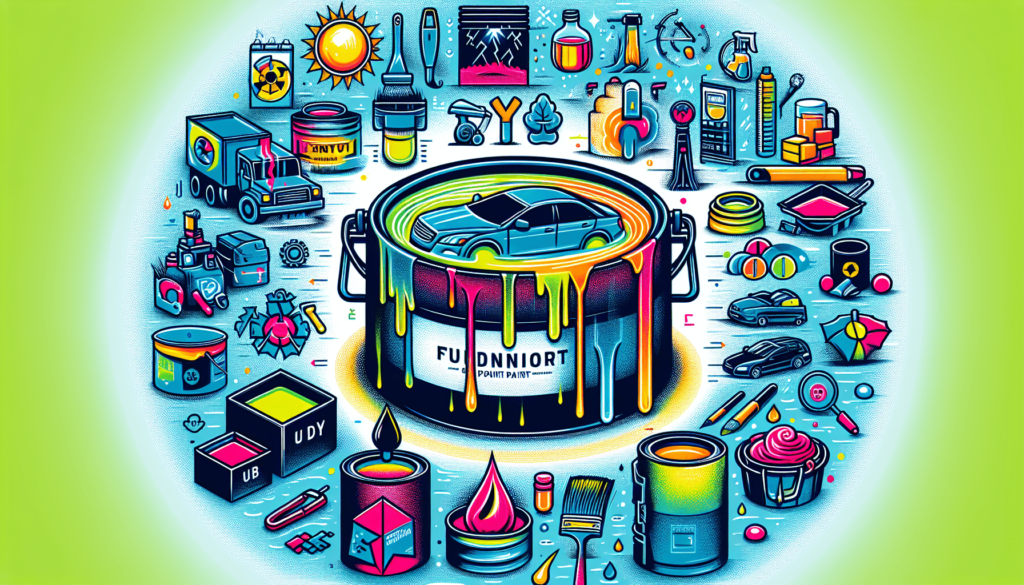Fluorescent paint, a popular choice for various applications ranging from artistic projects to safety signage, is cherished for its vibrant and eye-catching qualities. Understanding the longevity of fluorescent paint is crucial when considering its usage, as its brilliance tends to diminish over time. Determining the exact lifespan, however, can be intricate due to multiple factors that come into play. This article examines the key variables impacting the durability of fluorescent paint, providing insights into the average lifespan and valuable tips to extend its luminosity, ensuring your creations or safety measures retain their striking visual impact for an extended period.
Factors Affecting Fluorescent Paint Lifespan
Fluorescent paint is a popular choice for adding vibrant colors and glowing effects to various surfaces. However, the lifespan of fluorescent paint can vary depending on several factors. Understanding these factors can help you maximize the longevity of your fluorescent paint and ensure your investment is worthwhile.
Quality of the paint
The quality of fluorescent paint is a crucial factor in determining its lifespan. High-quality paints are formulated to withstand environmental conditions and provide long-lasting brightness. When purchasing fluorescent paint, it is essential to choose reputable brands that offer superior quality products. Investing in quality paint will ensure that it adheres well to surfaces, retains its fluorescent properties, and lasts for an extended period.
Exposure to light
Exposure to light plays a significant role in the lifespan of fluorescent paint. Prolonged exposure to direct sunlight or intense artificial light can cause the paint to deteriorate more rapidly. UV rays from sunlight can fade the vibrant colors and fluorescent properties of the paint over time. Choosing the right location for your fluorescent painted surfaces, such as avoiding areas with direct sunlight, can help protect them from excessive light exposure and extend their lifespan.
Environmental conditions
The surrounding environmental conditions can greatly impact the lifespan of fluorescent paint, especially for outdoor applications. Harsh weather conditions, such as extreme temperatures, humidity, rain, and snow, can accelerate paint degradation and compromise its longevity. Additionally, exposure to chemicals, pollutants, and airborne particles can also contribute to the deterioration of the paint. Understanding the environmental conditions in which your fluorescent paint will be exposed and taking appropriate measures to protect it can help prolong its lifespan.
Indoor Fluorescent Paint Lifespan
When used indoors, fluorescent paint typically has a longer lifespan compared to outdoor applications. The controlled environment and reduced exposure to harsh weather conditions contribute to the increased longevity of indoor fluorescent paint.
Typical lifespan
Under ideal conditions, indoor fluorescent paint can retain its vibrant colors and fluorescent properties for several years. However, the actual lifespan may vary depending on factors such as the quality of the paint, the level of light exposure, and the environmental conditions within the space.
Maintenance and care
Proper maintenance and care can further extend the lifespan of indoor fluorescent paint. Regular cleaning using mild soapy water and a soft cloth can help remove dust and dirt that may accumulate on the painted surfaces. Avoid using abrasive cleaning agents or harsh chemicals, as they can damage the paint. Additionally, avoiding excessive physical contact, such as scratching or rubbing, can help preserve the vibrant colors and prevent premature deterioration.

Outdoor Fluorescent Paint Lifespan
Outdoor applications of fluorescent paint are subjected to more rigorous conditions, making their lifespan comparatively shorter than indoor use.
Typical lifespan
The lifespan of outdoor fluorescent paint can range from a few months to a few years, depending on various factors. Exposure to UV rays, temperature fluctuations, moisture, and other environmental factors can contribute to faster deterioration of the paint. To ensure the longevity of outdoor fluorescent paint, regular maintenance and protective measures are necessary.
Weather conditions
Weather conditions significantly impact the lifespan of outdoor fluorescent paint. Extreme heat, cold, rain, and snow can cause fading, chalking, cracking, and peeling of the paint. Additionally, high humidity and exposure to saltwater or corrosive substances can also accelerate the paint’s degradation. Evaluating the local weather patterns and taking appropriate precautions, such as applying a protective clear sealant over the paint, can help mitigate the effects of adverse weather conditions and prolong the lifespan of outdoor fluorescent paint.
Maintenance and care
Regular maintenance and care are crucial for outdoor fluorescent paint to ensure its longevity. Regularly inspecting the painted surfaces for signs of deterioration and promptly addressing any issues can help prevent further damage. In addition to regular cleaning, consider applying a fresh coat of fluorescent paint periodically to rejuvenate the colors and maintain their vibrancy.
Storage and Shelf Life of Fluorescent Paint
Proper storage of fluorescent paint is essential to maintain its quality and extend its shelf life.
Proper storage
Fluorescent paint should be stored in a cool, dry place away from direct sunlight and extreme temperatures. Exposure to excessive heat or cold can impact the paint’s consistency and quality. Ideally, fluorescent paint should be stored in an airtight container to prevent air and moisture from entering and compromising its properties. Additionally, storing the paint in an upright position can help prevent settling or separation of pigments.
Shelf life
The shelf life of fluorescent paint varies depending on the brand and formulation. Typically, unopened fluorescent paint can last for several years if stored correctly. However, it is recommended to check the manufacturer’s guidelines or contact them directly for specific information on the shelf life of the paint you are using. Using paint that has exceeded its shelf life can result in reduced quality and performance.

Testing Fluorescent Paint Lifespan
Testing the lifespan of fluorescent paint can help assess its current condition and determine if any maintenance or repainting is required.
Using UV light exposure
One method to test the fluorescent paint’s longevity is by subjecting it to simulated UV light exposure. UV lamps or sunlight simulators can be used to evaluate how well the paint retains its fluorescent properties over time. Comparing the paint’s brightness and vibrancy before and after the exposure can provide valuable insights into its lifespan.
Visual observation
Regular visual observation of fluorescent painted surfaces can also help detect signs of deterioration. Look for any changes in color intensity, fading, chalking, cracking, or peeling. Documenting these observations over time can provide a clear picture of the paint’s lifespan and help plan for maintenance or repainting activities.
Consulting paint manufacturer
When in doubt or for accurate information on the lifespan of a specific fluorescent paint, consider contacting the manufacturer directly. They can provide insights into the expected lifespan of their product based on its formulation, quality, and intended use. Manufacturers may also offer guidance on maintenance and care practices to enhance the paint’s longevity.
Signs of Deteriorating Fluorescent Paint
There are several visible signs that indicate the deterioration of fluorescent paint. Recognizing these signs can help you take timely action to maintain or renew the painted surfaces.
Fading colors
One of the most apparent signs of deteriorating fluorescent paint is fading colors. The vibrant and intense hues may lose their brightness and appear dull over time. Faded colors can significantly diminish the visual impact of the painted surfaces and indicate the need for maintenance or renewal.
Chalking or powdering
As fluorescent paint ages, it may start to chalk or powder. This occurs when the paint gradually breaks down, resulting in a powdery residue on the surface. Chalking or powdering not only affects the paint’s aesthetics but also indicates the loss of its protective properties. It is crucial to address this issue promptly to prevent further deterioration.
Cracking or peeling
Cracking or peeling of fluorescent paint is a severe sign of deterioration. These issues often occur when the paint is exposed to harsh weather conditions or when there is poor adhesion to the surface. Cracks or peeled areas not only compromise the visual appeal of the painted surface but also leave it vulnerable to further damage. Repairs or repainting should be performed as soon as possible to prevent extensive deterioration.
Tips to Extend Fluorescent Paint Lifespan
Implementing the following tips can help you extend the lifespan of your fluorescent paint and maintain its vibrant appearance for a more extended period.
Apply primer before painting
Using a primer before applying fluorescent paint can enhance its adhesion to the surface and improve its longevity. Primers create a smooth and consistent base, reducing the risk of chipping, cracking, or peeling. They also help prevent the absorption of moisture, which can contribute to paint degradation.
Use multiple coats
Applying multiple coats of fluorescent paint can provide additional protection and prolong its lifespan. Each coat forms a barrier against external factors and reinforces the overall durability of the paint. However, ensure that each coat is allowed to dry thoroughly before applying the next one to achieve optimal results.
Ensure thorough drying
Proper drying is essential to ensure the longevity of fluorescent paint. Follow the manufacturer’s instructions for drying times and conditions. Avoid exposing freshly painted surfaces to excessive moisture or extreme temperatures during the drying process, as they can impact the paint’s adhesion and compromise its lifespan.
Avoid direct sun exposure
Direct sun exposure can accelerate the deterioration of fluorescent paint. Whenever possible, place fluorescent painted surfaces away from direct sunlight or provide adequate protection, such as shade or coverings, to minimize light exposure. Shielding the paint from excessive UV radiation can help maintain its vibrant colors for a more extended period.
Regular cleaning and maintenance
Regular cleaning and maintenance are vital to preserving the appearance and extending the lifespan of fluorescent paint. Use mild cleaning agents, such as soapy water, and a soft cloth to remove dust and dirt from the painted surfaces. Avoid using abrasive cleaners or harsh chemicals, as they can damage the paint. Regular maintenance also includes promptly addressing any signs of deterioration or damage to prevent further issues.
Factors That Reduce Fluorescent Paint Lifespan
While taking measures to extend the lifespan of fluorescent paint is important, certain factors can significantly reduce its life expectancy if not properly addressed.
Abrasive cleaning agents
Using abrasive cleaning agents, rough brushes, or harsh chemicals can damage fluorescent paint and shorten its lifespan. These substances can strip away the protective layers, damage the paint’s surface, and compromise its vibrant colors. Always opt for mild cleaning methods and suitable cleaning agents to prevent premature deterioration of the paint.
Low-quality paint
Using low-quality fluorescent paint can result in a considerably shorter lifespan. Inferior paints may not adhere well to surfaces, have weaker UV resistance, and exhibit faster color fading. When purchasing fluorescent paint, invest in reputable brands known for their quality products. The initial investment in high-quality paint will save you time and money in the long run by providing longer-lasting and more durable results.
Improper application
Improper application techniques can also reduce the lifespan of fluorescent paint. Inadequate surface preparation, failure to follow the manufacturer’s instructions, or applying the paint in unfavorable environmental conditions can all impact its performance and durability. It is crucial to carefully read and follow the paint manufacturer’s guidelines for proper application to ensure optimal results and an extended lifespan.
Renewing or Repainting Fluorescent Surfaces
When the fluorescent paint on a surface deteriorates beyond acceptable levels, renewing or repainting becomes necessary. The following steps provide a general guide for renewing a fluorescent surface:
Removing old paint
Before renewing the fluorescent surface, ensure that any old or deteriorated paint is completely removed. Use suitable paint removal techniques, such as sanding, scraping, or chemical strippers, based on the surface material and safety considerations.
Priming the surface
After removing the old paint, prepare the surface for fresh paint by applying a primer. The primer will provide a smooth base, improve adhesion, and enhance the durability of the new fluorescent paint.
Applying new fluorescent paint
Once the surface is properly primed, apply new fluorescent paint using the appropriate techniques. Follow the manufacturer’s instructions for drying times, curing periods, and recommended number of coats. Applying multiple coats, allowing thorough drying, and maintaining proper maintenance afterwards will help ensure the longevity of the newly applied fluorescent paint.
Conclusion
The lifespan of fluorescent paint is influenced by various factors, including the quality of the paint, exposure to light, environmental conditions, proper storage, and maintenance practices. Understanding these factors and implementing appropriate measures can help maximize the lifespan of fluorescent paint, whether used indoors or outdoors. Regular monitoring, cleaning, and timely repairs or repainting will ensure that fluorescent surfaces retain their vibrancy and visual impact for an extended period, providing a valuable and aesthetically pleasing addition to any space.



